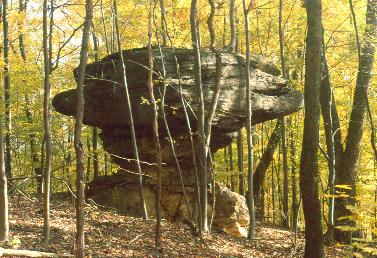
Devil's Tea-Table,
Waterloo Township,
Athens County, Ohio
Athens Conservancy GIS Center:
About GIS
Layers
A GIS system uses layers. Each layer is a computer file of one type of information. In the ESRI/ArcView system, these are called "shapefiles". One layer might be streams in a given area. One layer might be the roads in that same area. They are called layers because they are always stacked. There's one layer at the bottom, then each layer is added on top of that. The top layer is what shows completely. Layers below that might be partly covered by the top layers.
For instance, let's look at roads and streams. If the road layer is over the stream layer, then wherever a road and a stream cross, the computer will show the road, not the stream. It looks like the road goes over the stream. If the stream layer were on top, then it would look like the stream was flowing over the road.
Each layer is one particular type of data. Shapefiles have three kinds of data: point, line, and polygon. Point layers are 0-dimensional. Line layers are 1-dimensional. Polygon layers are 2-dimensional. The types cannot be mixed in a layer.
Point Layers
Point layers are useful for showing the simple location of things. For instance, when mapping quilt barns in our area, it would make sense to use a point layer for the location of each one. The point layer as shown on the map can be anything. It can be shown by stars, by circles, or by any other symbol that is useful.
Line Layers
Line layers are used extensively for roads, trails, railroad tracks, and streams -- anything that is a linear feature. But a line layer is one-dimensional, so does not automatically show the width or other characteristics of the feature, but only where it goes. However, a road can be shown by a single line for the centerline, which only shows the road's route, or by a double line for the two road edges, which also tells us how wide the road is. Lines are also used for topographic layers, also called contours. Each line shows a particular elevation, or distance above sea level.
Polygon Layers
Polygon layers show the most information. They show the actual sizes and shapes of things. They are good for representing ponds and lakes, buildings, political areas like city limits (which can also be shown using a line layer, but that has more limitations), areas under forest cover, and ownership parcels. A polygon can either be a filled shape, which typically shows as a solid color, or an outline only so that layers underneath the polygon show through the polygon layer.
Orthofotos
Orthofoto layers are also very important. Orthofotos ("orthophotos") are aerial photographs taken carefully at right angles to the ground surface so that they show, as accurately as possible, a true map view. These fotos are usually computer-adjusted to correct for parallax error. In the eastern United States, they are usually taken in winter in order to best show ground detail.
Other layers may be created using various geoprocessing techniques to create other effects such as elevation shading, which makes the finished map look more three-dimensional.
Projections and Coordinate Systems
GIS systems always use a particular map projection. Map projections are systems of choosing and using certain information to determine how and where the map information is shown. It makes relatively little difference which projection is used, as long as it is suitable for your location and is consistent between layers. Projection systems determine the relative size, positioning, and rotation of the information. This is necessary because the Earth is not flat. Coordinate systems then position each item within the projection in order to precisely locate it.
The Athens Conservancy uses the NAD (North American Datum) 1983 Ohio South projection.
GPS: Global Positioning System
GPS stands for global positioning system, and is NOT the same as GIS. GPS is a tool mostly used for checking the absolute location of something or someone on the surface of the Earth, and it works by bouncing signals off several satellites in order to accurately triangulate to determine location. However, GPS is a critically important tool in GIS mapping. GPS determines the precise locations of points according to the coordinate system, and this information can then be fed into a GIS system in order to exactly locate those points on the map. GPS determines points only -- but then, so does GIS. Enough points can be connected to make features that don't look like points.
Remote Sensing
While we have not provided remote sensing data links or been using remote sensing data other than orthofotos for seeing features in visible light, remote sensing is still critically important in GIS. Remote sensing usually uses satellites to record radiation from the surface of the Earth in various parts of the electromagnetic spectrum. In other words, a remote-sensing satellite can record image data in very specific "light" wavelengths. "Light" is in parentheses because many of these sensing bands are not visible light at all -- they may even be radio waves, microwaves, infrared, or ultraviolet.
Everything has a very specific spectrographic signature, and remote sensing data can be used to determine the nature of what is seen on the Earth's surface much better than relying on what is seen with the eye. For instance, a crop of corn will give off a specific signature, and the data can show that the field is, indeed, growing corn. Or marijuana. Or whatever.
Remote sensing is critically important in monitoring forest health, crop health, drought, heat pollution, climate, pollution, and many other environmental factors.